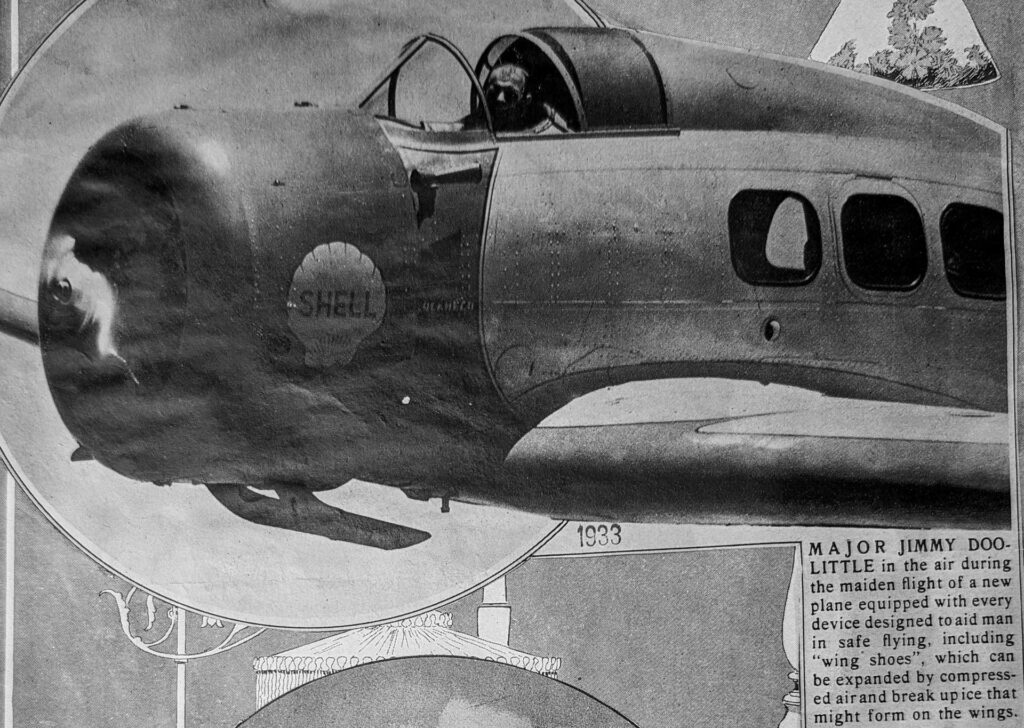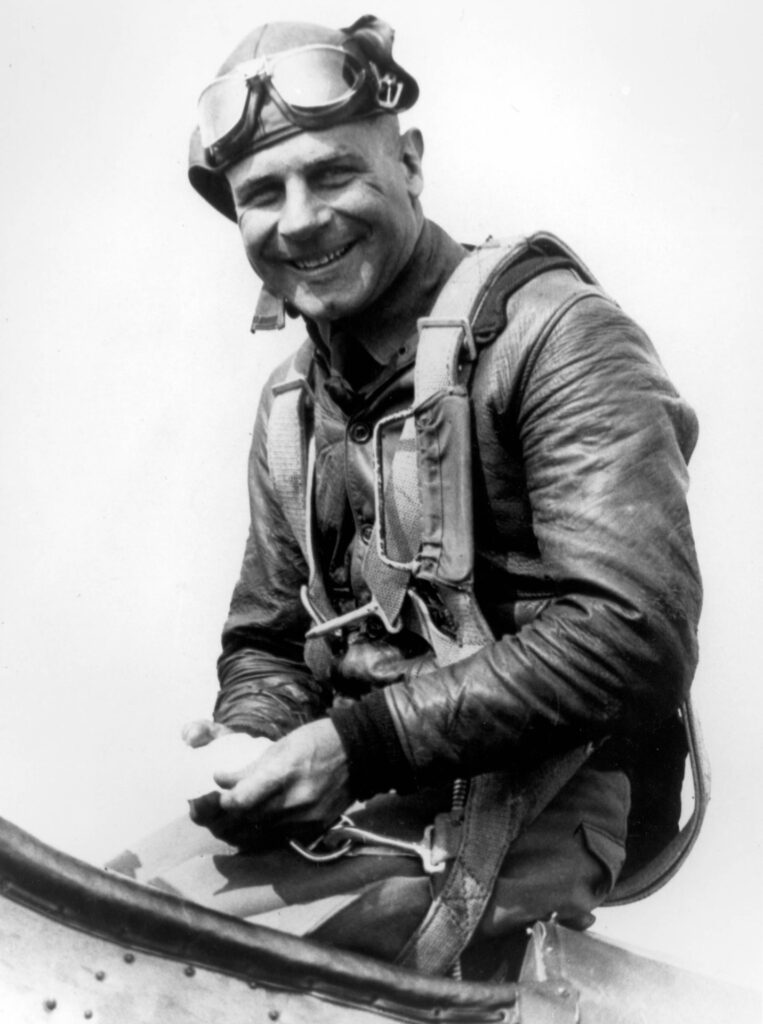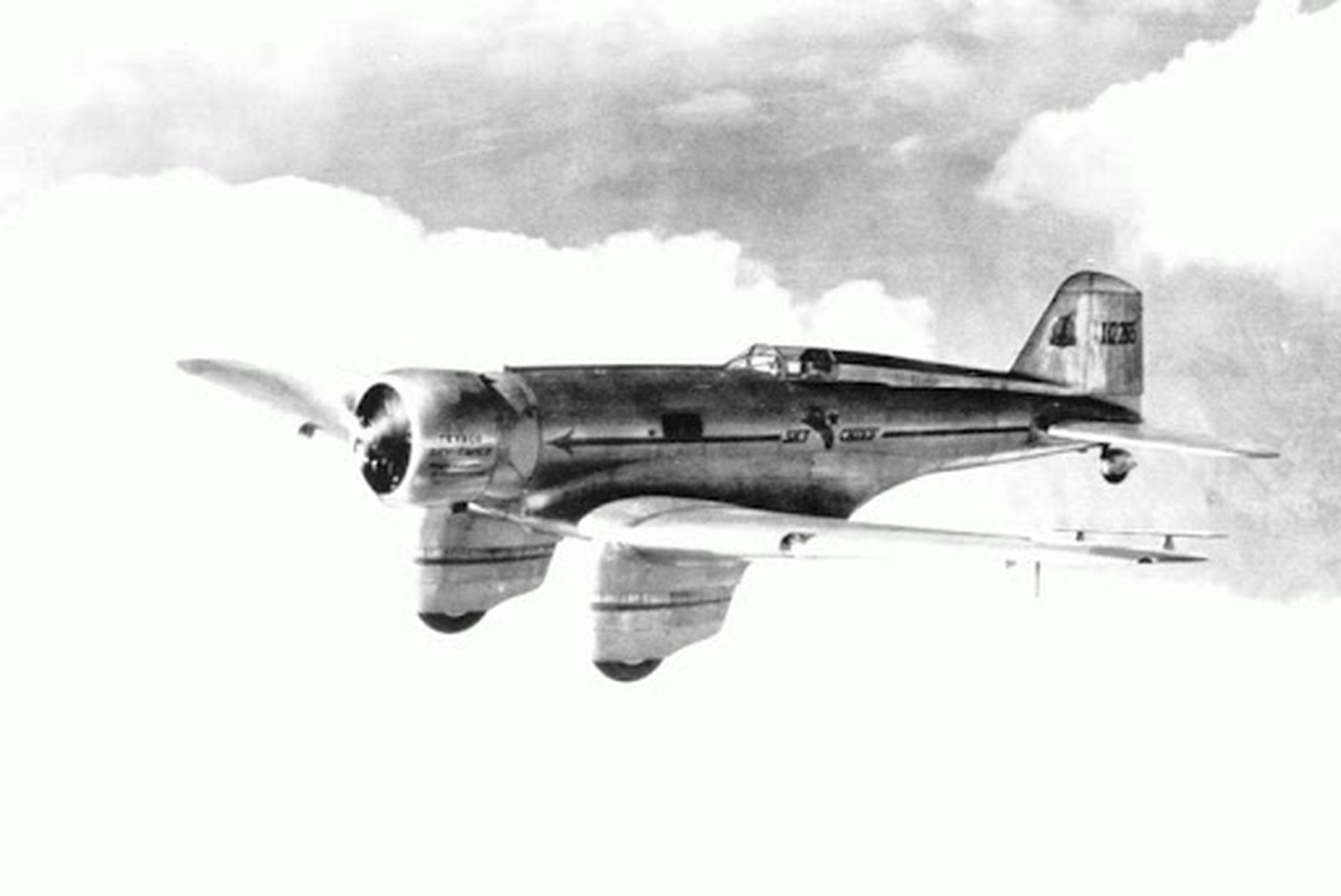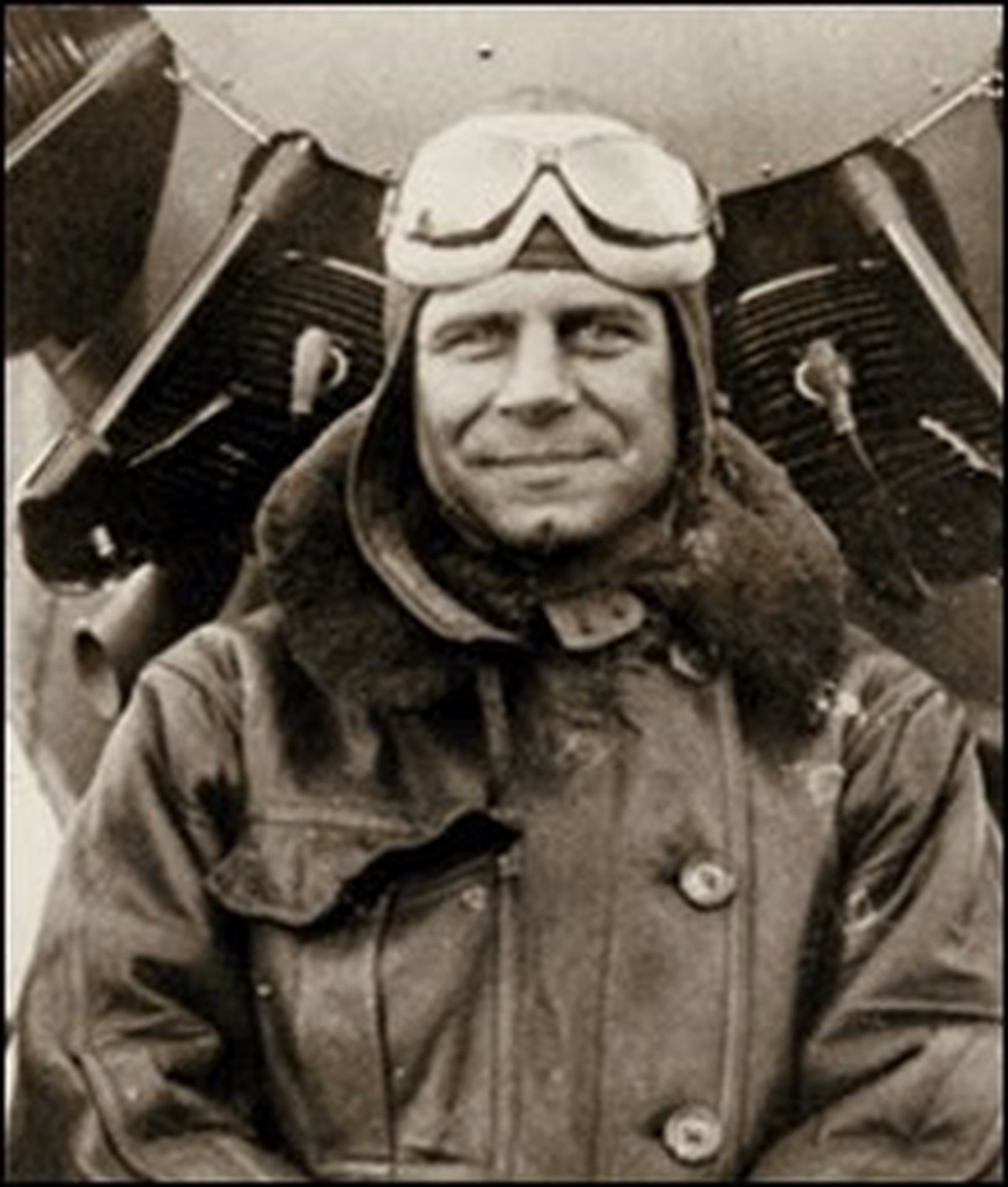Tony’s Scrapbook: Jimmy Doolittle

This image shows Major Jimmy Doolittle during the maiden flight of a new plane equipped with various safety devices, including “wing shoes” that can be expanded by compressed air to break up ice on the wings. The year mentioned is 1933, and the Shell logo is visible on the plane. Shell’s involvement highlights the intersection between industry and aviation, with corporate sponsorship playing a crucial role in funding and promoting technological advancements.
The airplane in the photo with Major Jimmy Doolittle is likely the Northrop Gamma. This aircraft played a significant role in developing and testing new aviation technologies during the early 1930s. It exemplified the innovative spirit of the time and contributed to advancements that would shape the future of aviation.
I am interested in both Jimmy Doolittle and the Northrop Gamma airplane. Let’s start with the Gamma and then move on to Mr. Doolittle. Does this sound like a plan? Good, let’s continue.
Jack Northrop produced the Gamma at his Northrop Corporation, which had a reputation for creating innovative and high-performance aircraft. The design for the Gamma was a single-engine, all-metal monoplane with a sleek design emphasizing aerodynamics and performance. Its low-wing configuration was relatively advanced in the early 1930s.
Initially designed for racing and setting speed records, the Gamma became a perfect candidate for exploration and scientific missions due to its high-speed capabilities. With various modifications showcasing its versatility, the Gamma became an ideal candidate for polar flights.
Some technical innovations include a newly invented de-icer and other pioneering safety features. As mentioned in the photo caption, one of the critical innovations tested on this aircraft was the “wing shoes,” an early de-icing technology designed to break up ice formation on the wings by expanding with compressed air. The plane likely incorporated other advanced safety features of the time, focusing on making aviation safer and more reliable.
Specific Models and Achievements
- Gamma 2B: One of the most famous versions, flown by Frank Hawks, set several speed records.
- Gamma 2C: Lincoln Ellsworth used this variant for polar exploration.
- Shell Oil Company: The Shell logo indicates corporate sponsorship, which is typical for funding innovative projects.
The early 1930s saw significant advancements in aviation technology, driven by the need for improved safety, performance, and reliability. Pilots like Jimmy Doolittle were at the forefront of testing these new technologies, contributing to the rapid development of aviation.
Major Jimmy Doolittle
- James Harold “Jimmy” Doolittle was a pioneering American aviator, aeronautical engineer, and Reserve officer in the United States Army Air Corps.
- He is best known for the famous Doolittle Raid during World War II. Still, his contributions to aviation began much earlier.
1933 Flight and Innovations
- 1933 saw rapid advancements in aviation technology. Pilots and engineers experimented with various safety and performance enhancements.
- The “wing shoes” mentioned in the caption refer to an early form of de-icing technology. Ice formation on aircraft wings can significantly impact performance and safety, and this technology aims to mitigate that risk by expanding to break up ice.
- This plane was likely a testbed for such new technologies, demonstrating their potential for enhancing aviation safety.
Doolittle’s Contributions to Aviation
- Jimmy Doolittle was a prominent figure in pushing the boundaries of what was possible in aviation. He earned a doctorate in aeronautical engineering from MIT, and his work included significant contributions to instrument flying, allowing pilots to fly in poor visibility conditions.
- In 1929, he made the first “blind” flight, relying entirely on instruments without visual reference to the ground. He showcased the potential for flying in adverse weather conditions.
I’m sure many people have covered the Doolittle Raid. Still, I find the history of our country very intriguing, so let’s do a quick history review.
The Doolittle Raid, also known as the Tokyo Raid, was a significant event during World War II. It was the first air raid by the United States to strike the Japanese home islands, specifically targeting Tokyo and other locations on Honshu. Here are the key details and historical context of the Doolittle Raid:
Planning and Preparation
Concept:
- The idea for the raid first started as a direct response to the attack on Pearl Harbor on December 7, 1941.
- The goal was to boost American morale and demonstrate that Japan was vulnerable to American air attacks.
Leadership:
- The raid was planned and led by Lieutenant Colonel James H. “Jimmy” Doolittle, a renowned aviator known for his pioneering work in aviation and aeronautical engineering.
Aircraft and Modifications:
- The raid used 16 B-25B Mitchell medium bombers, selected because they had the necessary range to reach Japan and could take off from an aircraft carrier.
- The bombers were modified to increase their range by removing unnecessary equipment and adding additional fuel tanks.
Training:
- The crews underwent intensive training in short takeoffs, as the B-25s had to take off from the deck of the USS Hornet, an aircraft carrier.
The Raid
Launch:
- On April 18, 1942, the U.S. launched the B-25 bombers from the USS Hornet, approximately 650 nautical miles from Japan.
- The original plan was to launch the bombers closer to Japan, but a Japanese patrol boat spotted them, forcing an earlier launch.
Targets:
- The primary targets included industrial and military sites in Tokyo, Yokohama, Yokosuka, Nagoya, and Kobe.
Execution:
- The bombers successfully reached Japan and dropped their bombs on the designated targets, causing damage to military and industrial installations.
- Due to the early launch, the bombers did not have enough fuel to safely reach the planned landing sites in China.
Aftermath:
- Most of the aircraft crash-landed, or the crews bailed out over China.
- Of the 80 crew members, 69 survived the mission. Chinese civilians and soldiers aided some, while Japanese forces captured others.
Impact and Significance
Psychological Impact:
- The raid had a significant psychological impact, boosting American morale and demonstrating that Japan was not invulnerable to air attacks.
- It also shocked the Japanese military and government, changing their defensive strategies and resource allocation.
Strategic Impact:
- The raid prompted Japan to hasten its plans to expand its defensive perimeter in the Pacific, contributing to the Battle of Midway.
- The raid demonstrated the potential of carrier-based air power, influencing future naval and air strategies.
Recognition:
- Jimmy Doolittle was promoted to Brigadier General and awarded the Medal of Honor for his leadership and bravery in planning and executing the raid.
Legacy
Cultural Legacy:
- The Doolittle Raid has been depicted in various films, books, and documentaries, highlighting its daring nature and importance in the broader context of World War II.
Commemoration:
- The raid receives commemoration annually, and its veterans have been honored for their bravery and contribution to the war effort.
The Doolittle Raid remains a testament to American ingenuity, courage, and determination during one of the darkest periods of World War II. It served as a pivotal moment that helped shift the momentum of the war in the Pacific.
I was going to end this post here, but I decided to look more deeply into Jimmy Doolittle’s life. He seems fascinating, so continue with me while I do so.
James Harold “Jimmy” Doolittle

Early Life and Education
- Born: December 14, 1896, in Alameda, California, USA.
- Childhood: He grew up in Nome, Alaska, where he developed an early interest in aviation and mechanical things.
- Education:
- He attended Los Angeles City College and the University of California, Berkeley, majoring in mining engineering.
- Joined the U.S. Army Signal Corps Aviation Section during World War I and became a flying cadet.
- He earned his pilot’s wings and was commissioned as a second lieutenant in the Signal Officers Reserve Corps in 1918.
Early Military Career
- World War I: Served as a flight instructor and test pilot but did not see combat.
- Post-War Achievements:
- Became a renowned test pilot and aerobatic pilot, setting several aviation records.
- Jimmy completed a doctorate in aeronautical engineering from the Massachusetts Institute of Technology (MIT) in 1925, with a dissertation on the wind velocity gradient.
- He pioneered instrument flying, demonstrating that pilots could rely on instruments rather than visual cues, significantly improving aviation safety.
Pre-World War II Achievements
- Schneider Trophy: Won the Schneider Trophy in 1925, setting a world seaplane speed record of 245 mph.
- Bendix Trophy: Won the Bendix Trophy in 1931 for a cross-country flight from Burbank, California, to Cleveland, Ohio.
- Blind Flying: In 1929, the first “blind” flight, relying entirely on instruments, showcased the potential for flying in adverse weather conditions.
World War II
- Return to Active Duty: Recalled to active duty in 1940 as a major in the Army Air Corps.
- Doolittle Raid: Planned and led the first U.S. air raid on the Japanese home islands (Tokyo Raid) on April 18, 1942. This daring mission boosted American morale and demonstrated Japan’s vulnerability.
- Medal of Honor: Awarded the Medal of Honor for his leadership and bravery during the raid. Promoted to brigadier general and then to major general.
- Post-Raid Service:
- Jimmy commanded the 12th Air Force in North Africa.
- He led the 15th Air Force in the Mediterranean Theater.
- He commanded the 8th Air Force in Europe, directing strategic bombing campaigns against Germany.
Post-War Career
- Retirement: Jimmy retired from the Air Force as a lieutenant general in 1959.
- Civilian Roles: Worked as a consultant and board member for various corporations, including Shell Oil Company.
Legacy and Honors
- Aviation Pioneer: Jimmy is known for his contributions to aviation safety, technology, and military strategy.
- Awards and Decorations:
- Medal of Honor
- Presidential Medal of Freedom
- Multiple Distinguished Flying Crosses and Distinguished Service Medals
- French Croix de Guerre and British Order of the Bath
- Cultural Impact: Jimmy’s life and achievements fill the pages of numerous books, including films and documentaries.
Personal Life
- Family: Married Josephine Daniels in 1917. They had two sons, James Jr. and John.
- Death: Passed away on September 27, 1993, at the age of 96 in Pebble Beach, California.
Jimmy Doolittle’s legacy as an aviation pioneer, war hero, and influential military leader remains significant. His contributions to both civil and military aviation have had a lasting impact on the field.
Well, this is another one for the books, and honestly, I didn’t remember the details of the famous Doolittle Raid. So, I hope you found this post as fulfilling as I did writing it.
As always, thank you for your interest in my writing, and I look forward to seeing you in the next one!
Discover more from Buffalo Air-Park
Subscribe to get the latest posts sent to your email.








